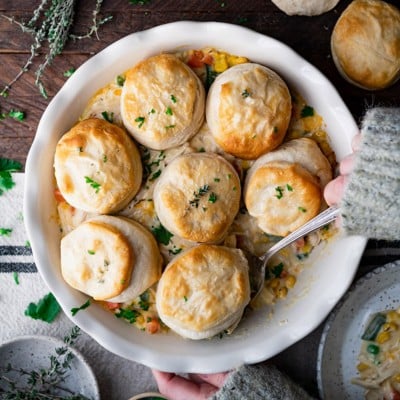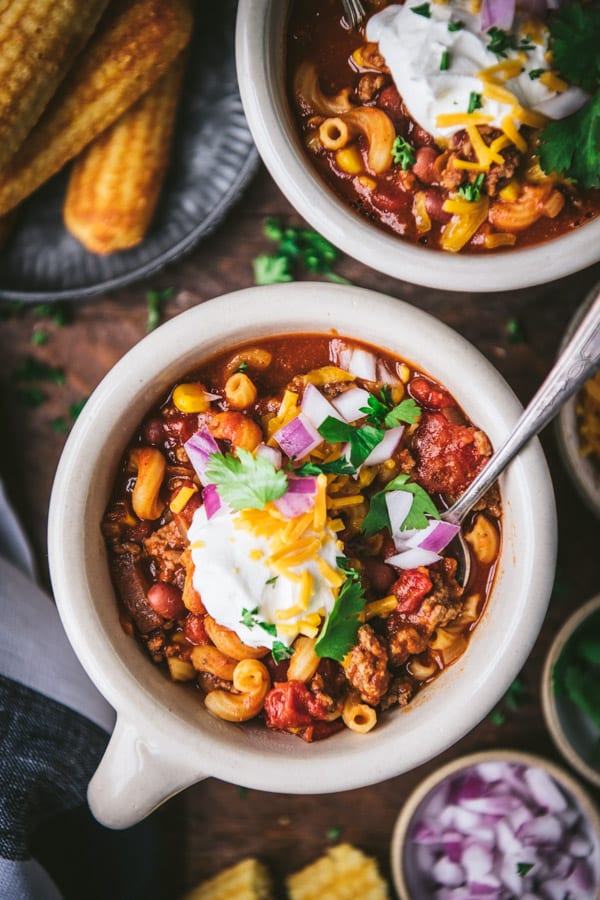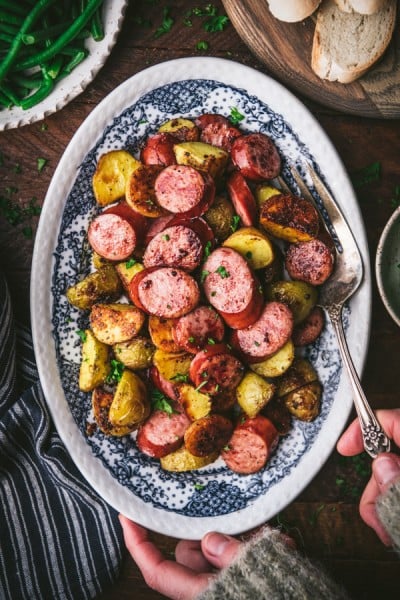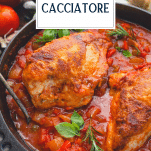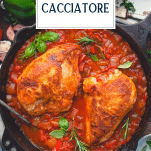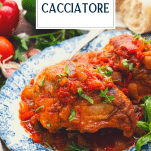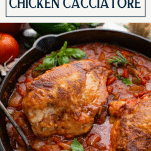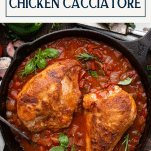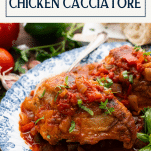Disclosure: This post may contain affiliate links. I may earn a small commission for my endorsement, recommendation, testimonial, and/or link to any products or services from this website.
Italian Hunter’s Chicken, also known as Chicken Cacciatore, includes tender, juicy chicken in a tomato-based sauce with onion, bell pepper, garlic and fresh herbs. It’s a rustic, flavorful, farmhouse favorite! Serve the easy dinner with rice, pasta, or a loaf of crusty bread for a cozy, family-friendly meal.
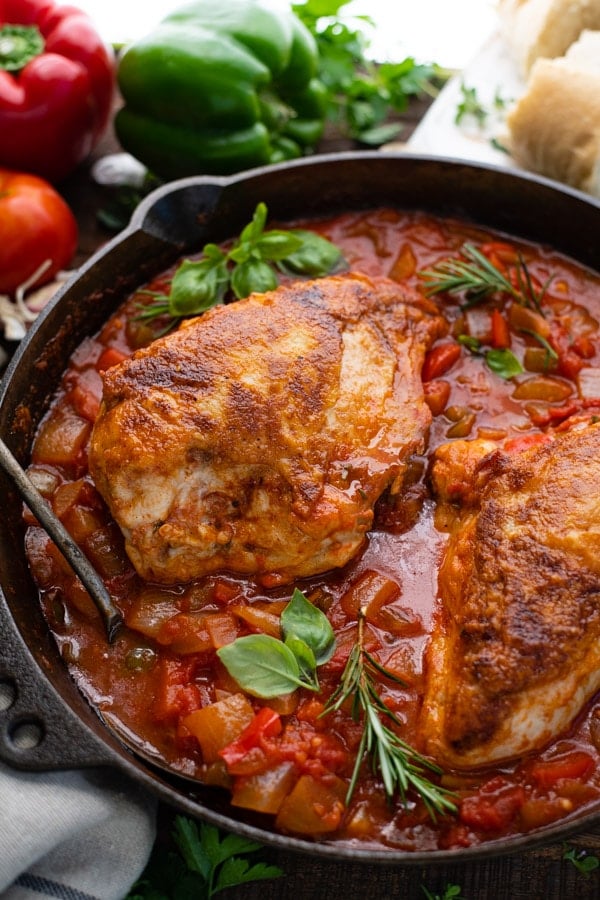
Why is it called Hunter’s Chicken?
Most cuisines around the world have a classic “hunter-style” chicken dish. The French version is known as “Chicken Chasseur,” since chasseur means “hunter” in French. Similarly, Italian Hunter’s Chicken is called “Chicken Cacciatore” or “pollo alla cacciatora,” as cacciatore means “hunter” in Italian.
Legend has it that Chicken Cacciatore [catch-ah-toh-ree], or chicken in the style of the hunter, originated somewhere in Central Italy in the Renaissance period (ca. 1450-1600). During that time period, only the Italian noblemen (who engaged in hunting as a sport) could afford to indulge in poultry — probably in the form of pheasant or quail (not actually chicken). While out on the hunt, the party would also gather herbs, mushrooms, onions, and other ingredients to use in preparing the fowl. As you can imagine, these ingredients came together in a hearty “hunter’s style” stew that was served with crusty bread for soaking up the sauce.
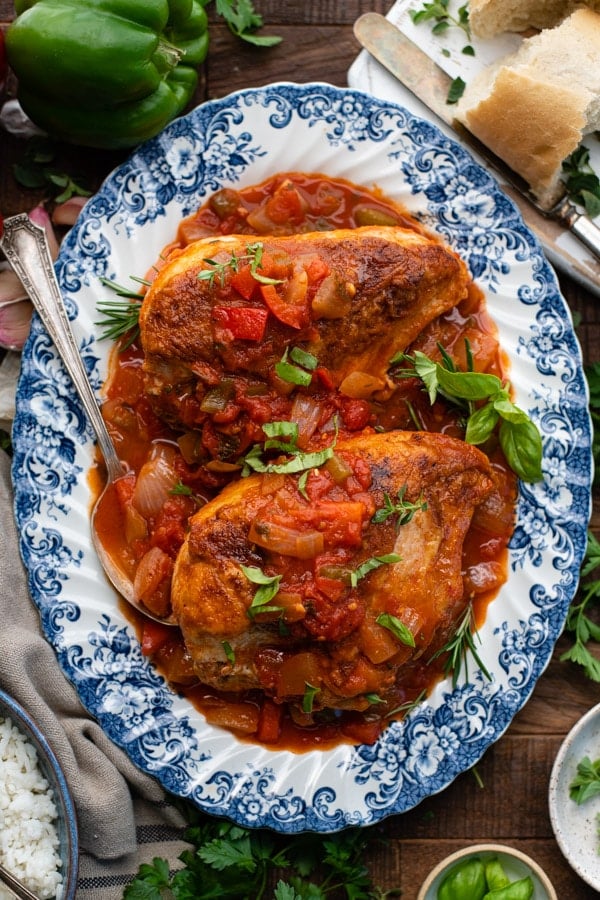
Chicken Cacciatore Recipe
There are as many different versions of chicken cacciatore as there are home cooks; however, this dish typically includes bone-in, skin-on chicken pieces browned in a skillet, then braised or simmered in a vegetable, herb and wine sauce. In America, the sauce almost always includes tomatoes, while different Italian variations take advantage of specific local ingredients. For instance, in southern Italy, cacciatore often includes red wine, while northern Italian chefs prefer white wine. Some recipes include mushrooms, others do not. The herbs may vary as well, from rosemary to basil, thyme or oregano.
As always, use this recipe as a jumping off point and make it your own! I’ve included a number of possible modifications below.
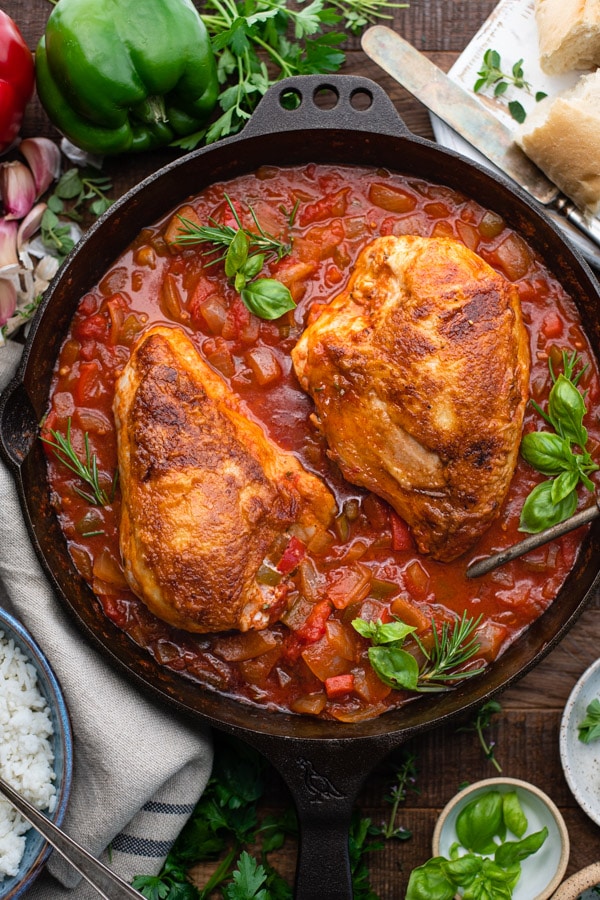
Ingredients
This is a quick overview of the simple ingredients that you’ll need for an easy chicken cacciatore recipe. As always, specific measurements and complete cooking instructions are included in the printable recipe box at the bottom of the post.
- Chicken: you’ll need bone-in, skin-on chicken pieces for the best flavor and texture. I recommend either breast, thigh, or a combination of the two.
- Kosher salt and black pepper: enhance the other flavors in the dish.
- All-purpose flour: for dredging the chicken, which helps the meat brown.
- Olive oil and butter: fat to sear the chicken.
- Red bell pepper, green bell pepper, onion and garlic: the base of the sauce.
- White wine: look for a dry white wine, such as Chardonnay, Pinot Grigio, or Sauvignon Blanc.
- Canned whole peeled tomatoes: San Marzano tomatoes, sweet Italian plum tomatoes from Campania, are best in this recipe.
- Chicken broth: to thin the sauce.
- Sugar: just a touch balances the acidity in the tomatoes and gives the sauce a more complex flavor.
- Oregano, rosemary and basil: use fresh herbs (when available) for the best flavor.
How to Make Chicken Cacciatore
This simple dish is ready from start to finish in about one hour. Set it to simmer on the stovetop and you’ll have a cozy, satisfying dinner that the whole family will enjoy.
- Season the chicken and dredge in flour.
- Brown the chicken in a skillet or Dutch oven, then remove to a plate.
- Simmer the sauce in the same skillet.
- Return the chicken to the pan and continue simmering for about 20-30 minutes, or until the meat is cooked through.
- Transfer the chicken parts to a plate.
- Bring the sauce to a boil and cook for about 5-7 more minutes, or until slightly thicker.
- Serve chicken with the sauce and garnish with fresh basil.
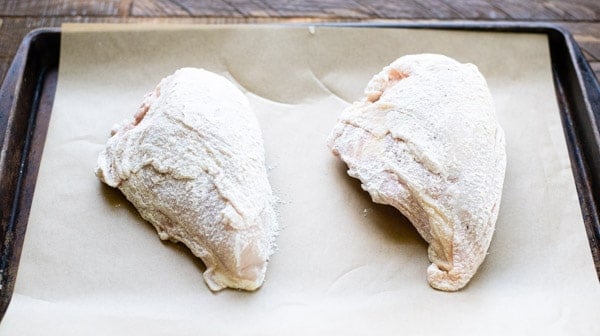
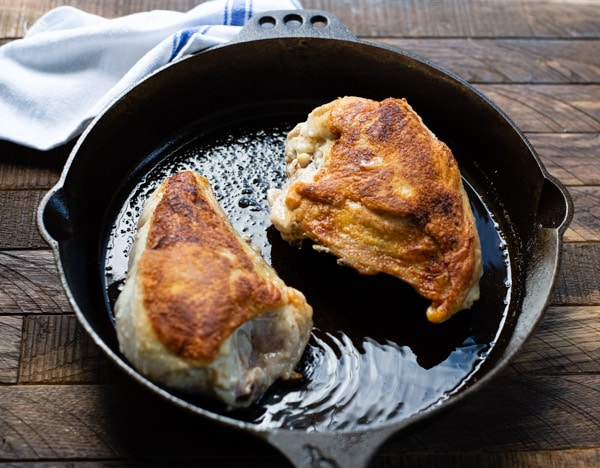
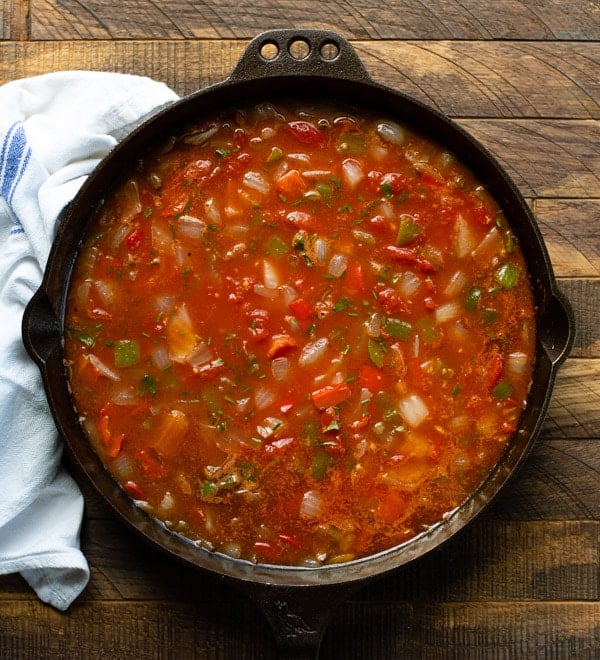
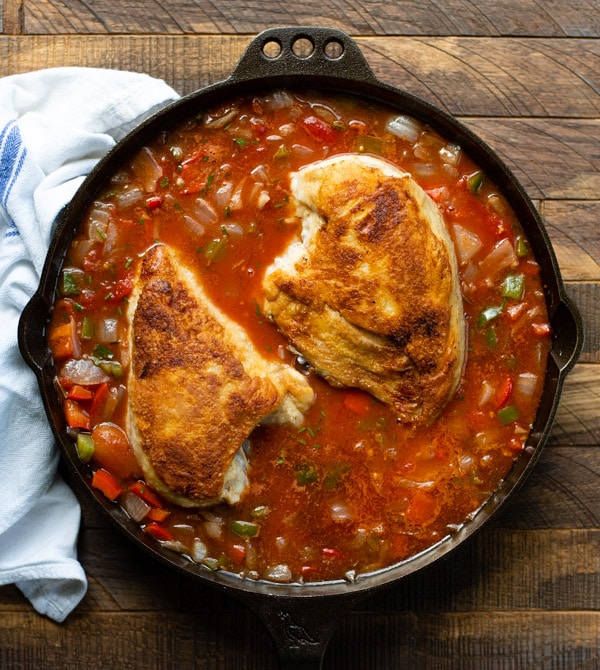
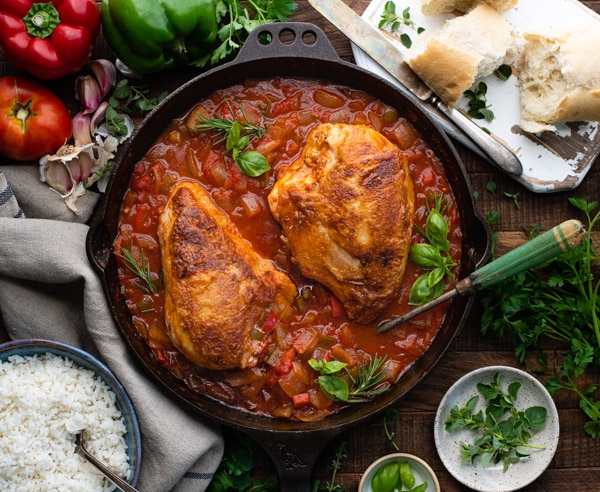
What to Serve with Italian Hunter’s Chicken
Hunter’s chicken is delicious when served with anything starchy that can soak up that rich, flavorful sauce. We love a baguette, a loaf of homemade focaccia, or this easy no-knead Dutch oven bread. Other good options include plain rice, Parmesan risotto, no-stir mushroom risotto, mashed potatoes, and pasta.
Storage
- Leftover chicken cacciatore will keep in an airtight container in the refrigerator for 3-4 days.
- Freeze: Let the sauce and chicken cool to room temperature, then transfer the mixture to a resealable container and freeze for up to 3 months. Thaw in the refrigerator overnight.
- Reheat: Transfer the chicken and sauce to a large saucepan or Dutch oven. Reheat gently over low heat, stirring occasionally, until warmed through.
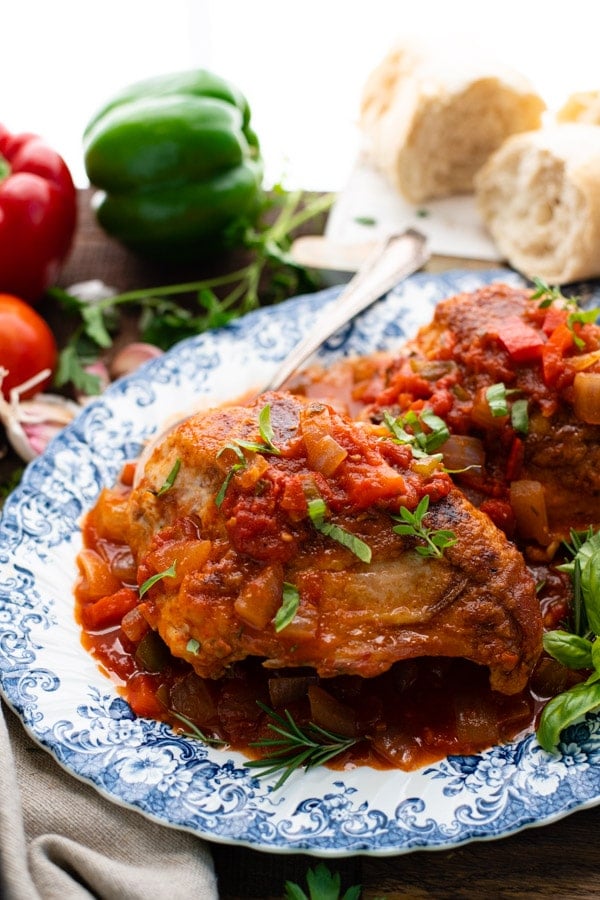
Recipe Variations
- Use chicken thighs, chicken breast, drumsticks, or a combination of the cut-up parts. Chicken breast requires a little bit longer cooking time, so adjust according to the recipe instructions below.
- If you can’t find San Marzano tomatoes, you can substitute with other whole, peeled tomatoes. A can of diced tomatoes will also work.
- For a richer, bolder sauce, use a dry red wine instead of the white wine.
- If you don’t want to use alcohol, substitute additional chicken broth for the wine.
- Add sliced mushrooms or finely-diced carrots to the sauce at the same time that you add the bell peppers.
- Black olives are another nice addition to the stew.
- Use just about any herbs that you enjoy, such as a combination of tarragon, parsley, rosemary, thyme, oregano and basil.
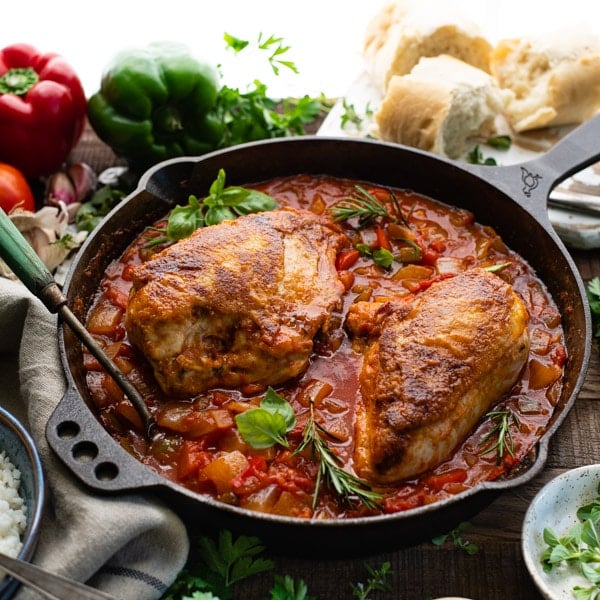
Tips for the Best Chicken Cacciatore Recipe
- Pat the chicken dry before seasoning and searing. Minimizing excess moisture helps the skin get crisp and brown in the pot.
- Use bone-in, skin-on chicken pieces rather than boneless, skinless thighs or breasts. The skin and bones add flavor to the dish and help to prevent the meat from drying out.
- If available, use San Marzano tomatoes. Sweet, pulpy, low in acidity, and containing few seeds, they are the best option for making sauces.
- Pick a high-quality dry white wine (nothing too sweet) such as Pinot Grigio, Sauvignon Blanc or Chardonnay.
- Instead of braising with the lid on, simmer the pot uncovered. This allows the sauce to thicken and reduce (so that it’s less watery), and keeps the chicken skin crisp.
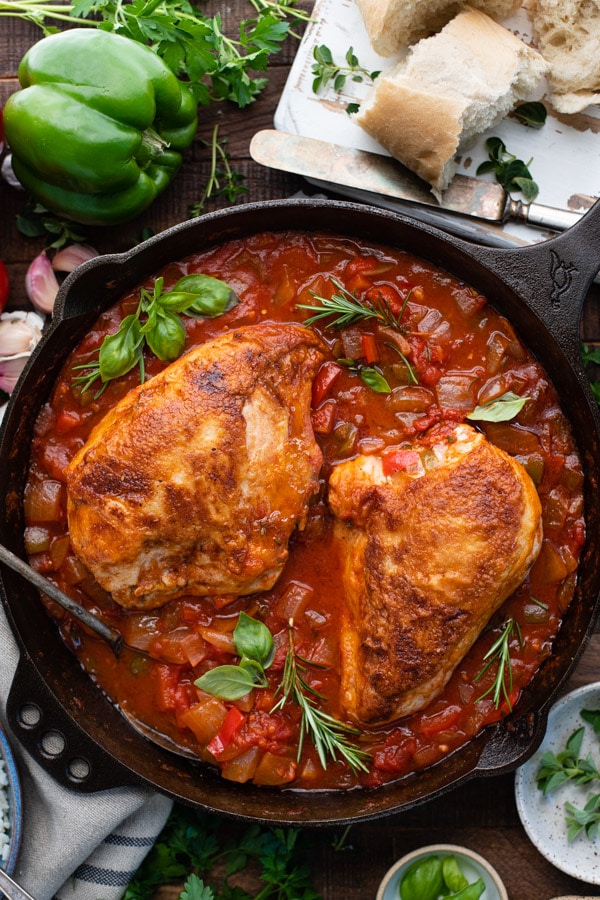
More Chicken Recipes to Try
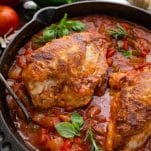
Chicken Cacciatore {Italian Hunter’s Chicken}
Ingredients
- 3-4 lbs. bone-in, skin-on chicken breasts or thighs
- Kosher salt and freshly-ground black pepper
- ½ cup all-purpose flour, for dredging
- 2 tablespoons olive oil
- 2 tablespoons butter
- 1 red bell pepper, seeded and chopped
- 1 green bell pepper, seeded and chopped
- 1 large onion, chopped
- 3 cloves garlic, minced or pressed
- ¾ cup dry white wine
- 1 (28 ounce) can whole peeled tomatoes with juices (preferably San Marzano)
- ¾ cup reduced-sodium chicken broth
- ½ teaspoon sugar
- 2 teaspoons chopped fresh oregano (or 1 teaspoon dried oregano)
- 1 teaspoon minced fresh rosemary (or ¼ teaspoon dried rosemary)
- ¼ cup chopped fresh basil (or sub with fresh parsley)
Instructions
- Pat the chicken dry; season with salt and pepper to taste. Dredge each piece of chicken in the flour to coat lightly, shaking off any excess.
- In a large, deep skillet or Dutch oven, heat the oil and butter over medium-high heat. Add the chicken pieces to the skillet and cook just until brown, about 5-6 minutes per side. Brown the chicken in two separate batches, if necessary, so that you don’t overcrowd the pan. Transfer the chicken to a plate and set aside.
- Reduce the heat to medium. Add the bell peppers, onion and garlic; cook until the onion is soft, about 5 minutes. Season with salt and pepper. Add the wine and simmer until reduced by half, about 3 minutes. Add the tomatoes with their juice, using a wooden spoon to break the tomatoes into smaller pieces.
- Stir in the broth, sugar, oregano and rosemary. Return the chicken pieces to the pot and turn to coat in the sauce. Bring the sauce to a simmer. Continue simmering over medium-low heat until the chicken is just cooked through, about 30 minutes for breast pieces (or about 20 minutes if using thighs).
- Use tongs to transfer the chicken pieces to a serving platter. Increase the heat and bring the sauce to a boil. Boil the sauce until it thickens slightly, about 5-7 minutes. Spoon the sauce over the chicken, garnish with fresh basil, and serve!
Notes
- Pat the chicken dry before seasoning and searing. Minimizing excess moisture helps the skin get crisp and brown in the pot.
- Use bone-in, skin-on chicken pieces rather than boneless, skinless thighs or breasts. The skin and bones add flavor to the dish and help to prevent the meat from drying out.
- If available, use San Marzano tomatoes. Sweet, pulpy, low in acidity, and containing few seeds, they are the best option for making sauces.
- Pick a high-quality dry white wine (nothing too sweet) such as Pinot Grigio, Sauvignon Blanc or Chardonnay.
- Instead of braising with the lid on, simmer the pot uncovered. This allows the sauce to thicken and reduce (so that it’s less watery), and keeps the chicken skin crisp.
- Use chicken thighs, chicken breast, drumsticks, or a combination of the cut-up parts. Chicken breast requires a little bit longer cooking time, so adjust according to the recipe instructions below.
- If you can’t find San Marzano tomatoes, you can substitute with other whole, peeled tomatoes. A can of diced tomatoes will also work.
- For a richer, bolder sauce, use a dry red wine instead of the white wine.
- If you don’t want to use alcohol, substitute additional chicken broth for the wine.
- Add sliced mushrooms or finely-diced carrots to the sauce at the same time that you add the bell peppers.
- Black olives are another nice addition to the stew.
- Use just about any herbs that you enjoy, such as a combination of tarragon, parsley, rosemary, thyme, oregano and basil.
- Recipe adapted from Giada de Laurentiis.

